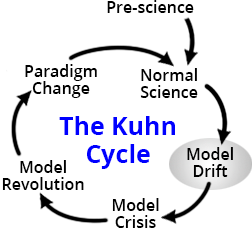Model Drift

Click a node to read about it.
Model Drift is the second step of the Kuhn Cycle. The cycle starts in Normal Science where a field has a model of understanding (its paradigm) that works. The model allows a field's members to solve problems of interest. When issues, problems, or phenomenon appear the model cannot handle, the model begins to drift away from Normal Science. As soon as more than a small amount of drift occurs, the field's paradigm is said to be in Model Drift.
In the System Improvement Process (SIP) excessive solution model drift occurs when a solution model works at first and then doesn't. The solution has drifted, due to change in the problem, change in how the solution is managed, or both. When the solution worked it was in the Normal Science step of the Kuhn Cycle. When it no longer works it's in the Model Crisis step.
A solution is a model of understanding about how a system should respond when the solution is implemented. If the model is correct the solution works. If not it fails. Thinking in these terms allows us to learn from the body of theory of the Kuhn Cycle and the rich history of the many past cycles of so many scientific fields.
Anomalies
Model drift is caused by what Thomas Kuhn called anomalies. An anomaly is an unexpected discovery one's paradigm cannot explain, which includes discovery of problems the paradigm cannot solve. Usually a model of understanding (a paradigm) can be modified to explain anomalies. This is how theories mature. But if some anomalies cannot be accommodated they begin piling up. If too many important anomalies accumulate, then the Kuhn Cycle advances to the next step of Model Crisis.
Examples of anomalies in science that led to Paradigm Change are:
The low rate of disease cure before discovery of germ theory.
The way only the top of a ship's mast was visible from a great distance. Eventually this anomaly was solved by the new theory that the earth is not flat but round.
Galileo's observation of the moons of Jupiter orbiting around Jupiter. This shattered the claim of the then dominant geocentric theory of the universe, which held that everything revolved around the earth. This was important support for the new heliocentric theory where the planets revolved around the sun.
Discovery of wave-particle duality. Classical Newtonian physics held that nature had "an independent verifiable existence, unaffected by the observation of the experimenter." (source) The wave-particle duality phenomenon showed that the experimenter affected the outcome of an experiment, no matter what he did. The anomaly was resolved by invention of quantum physics.
Examples of anomalies in social problems that led to Paradigm Change are:
The huge problems caused by the autocratic rule of kings, warlords, etc.
The obvious suffering of slaves and their families.
The obvious injustice of allowing only men to vote.
The obvious suffering and injustice of racial discrimination.
The above four anomalies were resolved by the same new paradigm of natural personal freedom from suffering and injustice. Freedom in an inherent natural right extending to all people. Once this paradigm began to become established, starting with birth of modern democracy in 1776 in America and 1789 in France, the paradigm grew to encompass the other anomalies.
The freedom paradigm is still growing because it offers a powerful justification of rights people would like to give themselves or others. In particular, this anomaly:
The anticipated suffering of future generations due to not solving the sustainability problem now.
is implied in the Brundtland definition of sustainable development:
Sustainable development is development that meets the needs of the present without compromising the ability of future generations to meet their own needs.
Why detecting excessive Model Drift is important
Thomas Kuhn states that:
Normal Science, the activity in which most scientists inevitably spend almost all of their time, is predicated on the assumption that the scientific community knows what the world is like. Much of the success of the enterprise derives from the community's willingness to defend that assumption, if necessary at considerable cost. Normal Science, for example, often suppresses fundamental novelties because they are necessarily subversive of its basic commitments. (page 5 of the 1996 edition)
Actually scientists spend much of their time in the Model Drift step, battling anomalies that have appeared. They may or may not know this or acknowledge it. When scientists suppress fundamental novelties they are denying they are in the Model Drift step, because the next step, Model Crisis, is so traumatic and threatening to the field and its members.
When you encounter fundamental novelties, such as inability of your field's paradigm to solve an important problem, it's best to acknowledge them and then get to work on them. Otherwise too many unexplained anomalies will accumulate and your field will be pushed into Model Crisis.
Karl Popper advised that when a theory fails (a fundamental anomaly appears), a scientists should reject the theory or propose an alternative theory. One should not leave the discrepancy unexplained.


























